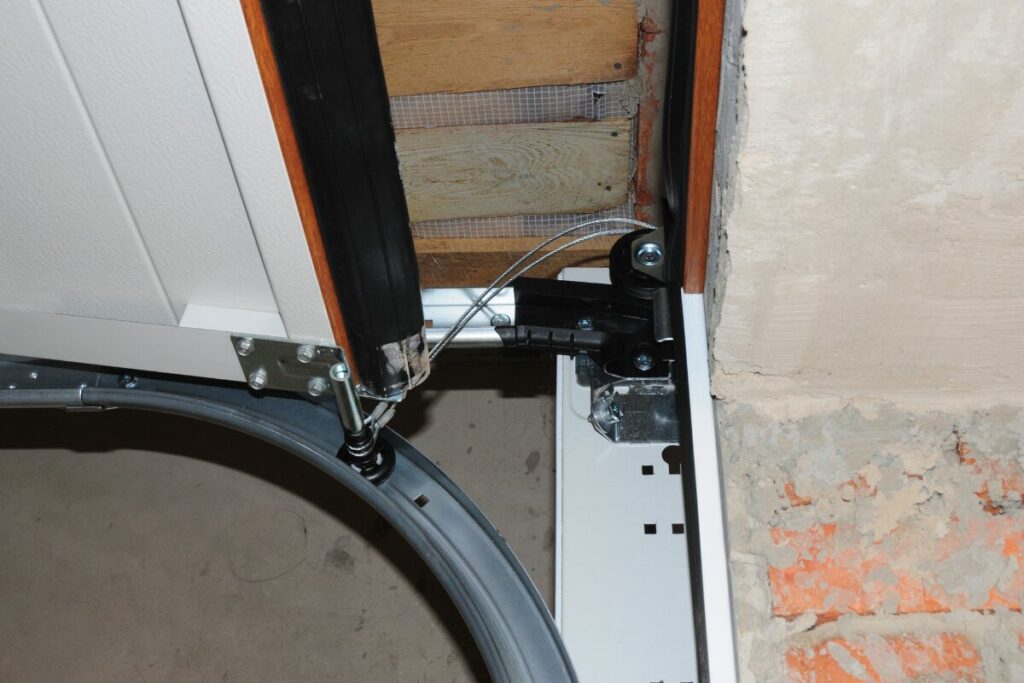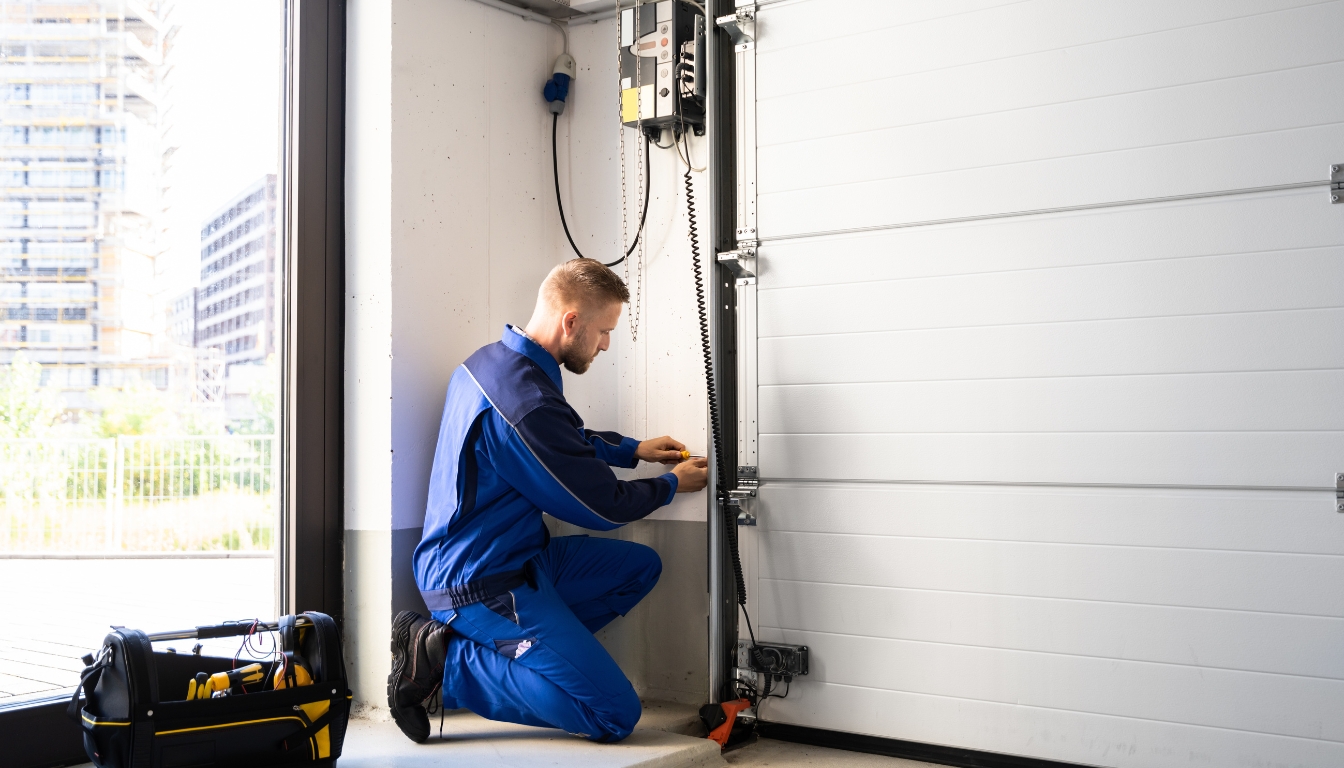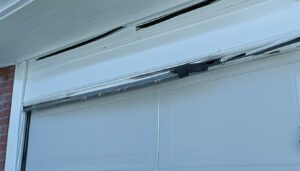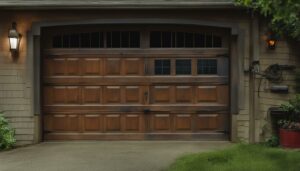Maintaining your garage door is essential to ensure its durability, functionality, and safety. By staying on top of regular maintenance and upkeep, you can extend its lifespan and avoid costly repairs or replacements. One important aspect in making the your garage door is to perform garage door track maintenance. Cleaning the tracks and ensuring proper alignment is crucial for smooth operation and preventing jams. Regular track inspection, alignment, and lubrication are key to keeping your garage door functioning optimally. Here are some tips on how to maintain your garage door tracks.
Key Takeaways:
- Cleaning and aligning the garage door tracks is crucial for smooth operation and preventing jams.
- Regular track inspection and lubrication help maintain optimal garage door performance.
- Remove debris from the tracks and clean them using a mild detergent and water solution.
- Properly align the tracks vertically and ensure they are parallel to the wall.
- Use the right type of lubricant, such as white lithium grease or silicone-based lubricant, on the rollers and hinges.
Visual Inspection of the Garage Door
A visual inspection is a crucial step in maintaining the functionality and longevity of your garage door. By carefully examining various components, you can identify any issues or potential problems that may affect its performance. Here’s a comprehensive guide on how to conduct a thorough visual inspection of your garage door:
- Inspect the door panels for any surface damage such as cracks, dents, holes, or warping. Ensure that the panels are flush and properly aligned.
- Check the hinges for signs of wear and tear, rusty patches, and rust or corrosion on metal hinges. Additionally, make sure that all screws on the hinges are tight and secure.
- Examine the rollers and determine if they are made of the appropriate material and in good condition. Replace any rollers that show signs of chips, wear, or cracks. Make sure that the rollers are aligned within the tracks and remove any obstructions or debris that may hinder smooth operation.
- Inspect the tracks for any signs of rust, damage, or misalignment. Ensure that the tracks are parallel and vertically aligned with the wall.
- Check the garage door springs for proper tension and any signs of rust, wear, breaks, or fraying. Ensure that the cables are securely attached at both ends and that they are in good condition.
- Inspect the rubber seal at the bottom of the door for any cracks or breaks. The seal helps prevent drafts, debris, and pests from entering the garage.
- Finally, examine all nuts, bolts, and screws on the garage door to ensure they are tight and not corroded. Loose or corroded fasteners can affect the stability and functionality of the door.
By conducting a thorough visual inspection using the above guidelines, you can identify and address any issues before they escalate into more significant problems. Regular maintenance and visual inspections are key to keeping your garage door in optimal working condition.
| Components | Points to Check |
|---|---|
| Door Panels | Surface damage, alignment issues |
| Hinges | Rusty patches, wear and tear, loose screws |
| Rollers | Material check, alignment, obstructions in tracks |
| Tracks | Rust and damage, alignment issues |
| Springs and Cables | Tension, rust and wear, breaks, fraying, attachment points |
| Rubber Seal | Condition, fit, cracks or breaks |
| Nuts, Bolts, and Screws | General examination, garage door nuts and bolts |
 Cleaning and Lubricating the Garage Door Tracks
Cleaning and Lubricating the Garage Door Tracks
To ensure the smooth operation of your garage door and reduce wear and tear, proper cleaning and regular lubrication of the tracks are essential. This maintenance routine helps prevent the build-up of dirt, debris, and corrosion, promoting the longevity of your garage door. Follow these steps to effectively clean and lubricate your garage door tracks:
- Clean the Tracks: Start by mixing a mild detergent with water. Use a soft cloth or sponge to gently scrub the tracks, removing any dirt or debris. For wooden doors, avoid using harsh chemicals that may damage the surface. Check and clean any rust spots on metal doors using a window or glass cleaner. Ensure you remove all dirt and debris from the tracks using a cloth or small brush.
- Clean the Rubber Seal: Don’t forget to clean the rubber seal at the bottom of your garage door. Create a water-detergent solution and use it to wash the rubber seal thoroughly.
- Rinse: After cleaning, thoroughly rinse the tracks and the rubber seal with clean water. Make sure to remove any soapy residue and allow the door and its components to dry completely.
- Apply the Right Lubricant: Use the right kind of lubricant to ensure optimal performance and minimize attracting dirt. For the rollers and hinges, use either white lithium grease or a silicone-based lubricant. Apply a small amount of lubricant across the top of the springs. Avoid using standard WD-40 as it can attract dirt and debris.
- Remove Excess Lubricant: Wipe away any excess lubricant with a clean cloth to prevent drips and build-up.
Regular cleaning and lubrication of your garage door tracks will help maintain their smooth operation, reduce wear and tear, and extend the lifespan of your garage door.
Recommended Cleaning and Lubrication Materials
| Material | Usage |
|---|---|
| Mild detergent | Cleaning tracks and rubber seal |
| Water | Rinsing tracks and rubber seal |
| Soft cloth or sponge | Cleaning tracks |
| Window or glass cleaner | Cleaning rust spots on metal doors |
| White lithium grease | Lubricating rollers and hinges |
| Silicone-based lubricant | Lubricating rollers and hinges |
Maintaining Garage Door Balance and Safety Features
Maintaining the balance of your garage door is vital for its smooth operation and to prevent strain on the opener. An imbalanced garage door can lead to premature wear and tear on the components and may pose safety risks. To determine if your garage door is properly balanced, you can perform a simple test.
Manual Operation: Halfway Lift Test
Start by disconnecting the opener or pulling the release handle to disengage the automatic operation. Next, manually lift the garage door halfway. If the door stays in place without falling or rising on its own, it is balanced. However, if it falls or rises, it indicates an imbalance that needs to be addressed.
Imbalances can be caused by issues such as incorrect spring tension or worn-out components. It’s important to contact a professional technician to assess and correct any imbalances to ensure the safe and efficient operation of your garage door.
Safety Features: Auto-Reverse Mechanism and Sensor Alignment
Garage doors are equipped with safety features designed to prevent accidents and injuries. Two common types of safety features are mechanical auto-reverse and photoelectric auto-reverse.
The mechanical auto-reverse mechanism is triggered when the door encounters resistance while closing. This test can be performed by placing a solid object, such as a roll of paper towels, in the path of the closing door. The door should automatically reverse upon contact with the object. If the door does not reverse, there may be an issue with the auto-reverse mechanism that needs to be addressed by a professional technician.
The photoelectric auto-reverse test uses photo eyes or sensors positioned on each side of the garage door. These sensors emit an invisible beam of light that, when broken, signals the door to reverse its movement. You can perform this test by waving a long object, like a broomstick, in front of the photo eyes while the door is closing. If the door does not immediately reverse upon breaking the beam, there may be a misalignment or obstruction interfering with the sensors. Ensure that the photo eyes are clean and properly aligned. Use a soft cloth to clean the lenses and avoid any damage to the photo eyes during the process.
Regular Testing and Garage Door Technology Upgrades
Regularly testing the balance and safety features of your garage door is essential to ensure ongoing functionality and safety. Schedule periodic tests, preferably every three to six months. This proactive approach can identify any issues before they escalate into more significant problems.
Additionally, stay informed about advancements in garage door technology. Upgrades in safety features, such as improved auto-reverse mechanisms or enhanced photo eyes, can provide added protection and peace of mind. Consult with a professional technician to discuss the availability and compatibility of these upgrades for your specific garage door system.
By prioritizing the maintenance of garage door balance and safety features, you can ensure the longevity, reliability, and safety of your garage door for years to come.

Garage Door Hardware Inspection and Maintenance
Regular inspection and maintenance of the garage door hardware is essential for identifying signs of deterioration and preventing issues. Here are some key areas to focus on:
Tracks and Hinges
Inspect the tracks and hinges for any signs of wear and tear. Look for dents, cracks, or misalignment. Tighten any loose bolts or fasteners using a socket wrench or screwdriver to ensure stability and smooth operation.
Garage Door Rollers
Check the garage door rollers that are not connected to the lift cable system. Look for signs of wear, such as chipping or flattening. If the rollers appear worn, it is recommended to replace them to maintain optimal performance.
Lift Cables and Worn Lift Wires
Inspect the lift cables for signs of wear, rust, damage, or broken strands. If the cables appear worn, contacting a professional for replacement is advised. Attempting to replace garage door cables on your own can be dangerous as they are under high tension.
Garage Door Cables and Nuts and Bolts
Check the garage door cables for any signs of wear or damage. Look for fraying, rust, or broken strands. Also, inspect the garage door nuts and bolts for tightness and corrosion. It’s important to ensure that all the hardware components are securely in place to maintain the door’s functionality.
Garage Door Balance
Ensure that your garage door is properly balanced. A balanced door is crucial for smooth operation and to prevent strain on the opener. If you notice any imbalance or difficulty in opening or closing the door, it’s recommended to seek assistance from a professional to adjust the tension or springs.
Regular hardware maintenance helps prolong the life of your garage door and ensures its proper functioning. By staying vigilant and addressing any signs of deterioration promptly, you can prevent potential issues and avoid costly repairs or replacements.
Continue to the next section for tips on cleaning the surface of your garage door and maintaining the weatherstripping.
Cleaning the Garage Door Surface and Maintaining the Weatherstrip
Keeping your garage door surface clean and maintaining the weatherstrip are essential for prolonging the life of your garage door. Follow these cleaning and maintenance tips to ensure optimal performance and appearance.
Garage Door Surface Cleaning
For wooden garage doors, use a soft cloth and an appropriate cleaner to wipe down the surface. This gentle approach will help prevent damage to the wood. If you have vinyl or synthetic garage doors, wash them using a soft cloth and the appropriate cleaner. Afterwards, rinse the doors with a hose and dry them with a microfiber cloth. By removing dirt and grime, you’ll maintain the door’s aesthetics and prevent unnecessary wear.
Pro Tip: When cleaning the inside of your garage door, be sure to remove any cobwebs using a soft, dry cloth.
Weatherstripping Maintenance
Weatherstripping is a crucial component of your garage door that helps seal and insulate the space, preventing drafts, debris, and pests from entering. It also improves energy efficiency. Regularly inspect the weatherstripping for any signs of wear or damage, and replace any worn-out sections promptly.
Did You Know? Clean and pliable weatherstripping ensures a tight seal on your garage door, protecting it from the elements and improving insulation.
Use a vinyl cleaner to keep the weatherstripping clean and pliable. Regular maintenance of the weatherstrip will help extend its lifespan and preserve the overall integrity of your garage door.
Garage Door Surface Cleaning and Weatherstripping Maintenance
| Garage Door Material | Cleaning Method | Maintenance Tips |
|---|---|---|
| Wooden | Use a soft cloth and appropriate cleaner to wipe the surface | Inspect for repainting or staining needs and patch small holes before applying |
| Vinyl or Synthetic | Wash with a soft cloth and appropriate cleaner, rinse with a hose, and dry | Regularly check for damage or cracks and replace if necessary |
By cleaning the surface of your garage door and maintaining the weatherstripping, you’ll not only enhance its appearance but also ensure proper insulation and protection against the elements. Implementing these simple maintenance practices will help your garage door stand the test of time.
Conclusion
Regular maintenance is key to ensuring smooth and trouble-free operation of your garage door. By taking the time to perform simple tasks such as regular track maintenance, cleaning and lubrication, visual inspection, safety feature tests, hardware inspection, surface cleaning, and weatherstripping maintenance, you can greatly extend the lifespan of your garage door and prevent costly repairs. It’s important to stay proactive and address any issues promptly to avoid further damage and inconvenience.
Regular visual inspection allows you to identify any signs of wear, damage, or misalignment, ensuring that your garage door remains in proper working condition. By cleaning and lubricating the tracks, you can reduce friction and prevent debris buildup, allowing for smoother door operation. Checking and testing the safety features of your garage door, including auto-reverse mechanisms and sensor alignment, is crucial to ensure the safety of you and your family.
Additionally, maintaining the hardware and keeping the surface clean not only enhances the appearance of your garage door but also contributes to its overall functionality. Regularly inspecting and tightening bolts and fasteners, as well as cleaning the weatherstripping, helps protect your door from the elements and improves energy efficiency.
While regular maintenance can prevent many issues, it’s important to recognize when it’s time to seek professional help or consider a garage door replacement. If you encounter major problems such as broken springs or cables, severely damaged panels, persistent motor or opener issues, or an aging door that requires frequent repairs, it’s best to consult a professional. They will be able to provide expert advice and guidance on the best course of action, ensuring the safety and durability of your garage door for years to come.
FAQ
Why is garage door track maintenance important?
Maintaining garage door tracks is important to ensure smooth operation, prevent jams, and extend the lifespan of your garage door.
How do I visually inspect my garage door?
During a visual inspection, check for surface damage, proper alignment, rusty patches, wear and tear, loose screws, and debris in the tracks.
How should I clean the garage door tracks?
To clean the tracks, use a mild detergent mixed with water and a soft cloth or sponge. Avoid using harsh chemicals and clean any debris with a cloth or small brush.
What lubricant should I use for the garage door tracks?
Use white lithium grease or a silicone-based lubricant for the rollers and hinges. Avoid using standard WD-40 as it can attract dirt.
How do I maintain the balance of my garage door?
Disconnect the opener and manually lift the door halfway to test the balance. If the door falls or rises, there is an imbalance that needs to be adjusted by a professional.
Why should I test the safety features of my garage door?
Testing the safety features helps prevent accidents and injuries. Perform mechanical and photoelectric auto-reverse tests to ensure the door reverses properly upon contact with an object or when the beam is broken.
How often should I inspect and maintain the garage door hardware?
Regular inspection and maintenance of the hardware is essential. Check for signs of wear and tear, tighten loose bolts or fasteners, and replace worn-out components as needed.
How do I clean the garage door surface?
Use a soft cloth and appropriate cleaner to clean wooden, vinyl, or synthetic garage doors. Remove cobwebs with a dry cloth and patch any small holes before repainting or staining.
What is the role of weatherstripping in garage door maintenance?
Weatherstripping helps seal and insulate the garage door, improving energy efficiency and keeping out drafts, debris, and pests. Regularly inspect and replace worn-out weatherstripping sections.
When should I seek professional help or consider a new garage door?
If you encounter broken or damaged springs or cables, severely damaged panels, persistent motor or opener problems, or an older door that requires frequent repairs, it may be time to consult a professional or consider a new garage door.




